Business Model Analysis: eBay Case Study and Development
VerifiedAdded on 2020/03/04
|7
|2099
|63
Essay
AI Summary
This essay provides a comprehensive analysis of business models, beginning with definitions and an exploration of e-business model archetypes (product, service, and trade) and secondary archetypes (brokerage, marketplace, and subscription). It then delves into business model as an activity system and revenue architecture, emphasizing their roles in value creation and revenue generation. The essay also discusses the importance of business context. The analysis extends to a case study of eBay, examining its value chain, strengths, weaknesses, and the need for adapting its service archetype model to address competitive challenges. The conclusion highlights the significance of aligning business models with industry-specific requirements and provides a practical example of model application.
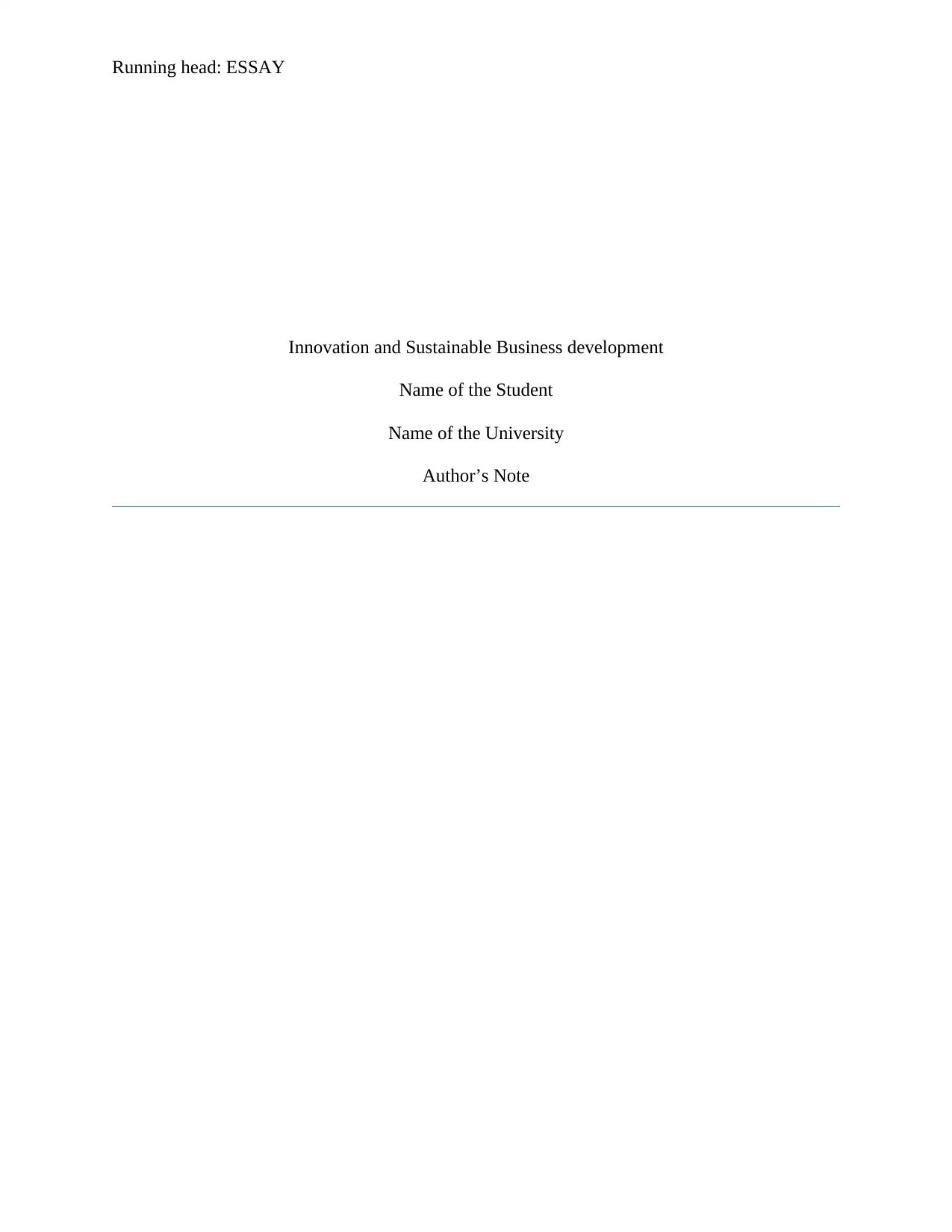
Running head: ESSAY
Innovation and Sustainable Business development
Name of the Student
Name of the University
Author’s Note
Innovation and Sustainable Business development
Name of the Student
Name of the University
Author’s Note
Paraphrase This Document
Need a fresh take? Get an instant paraphrase of this document with our AI Paraphraser
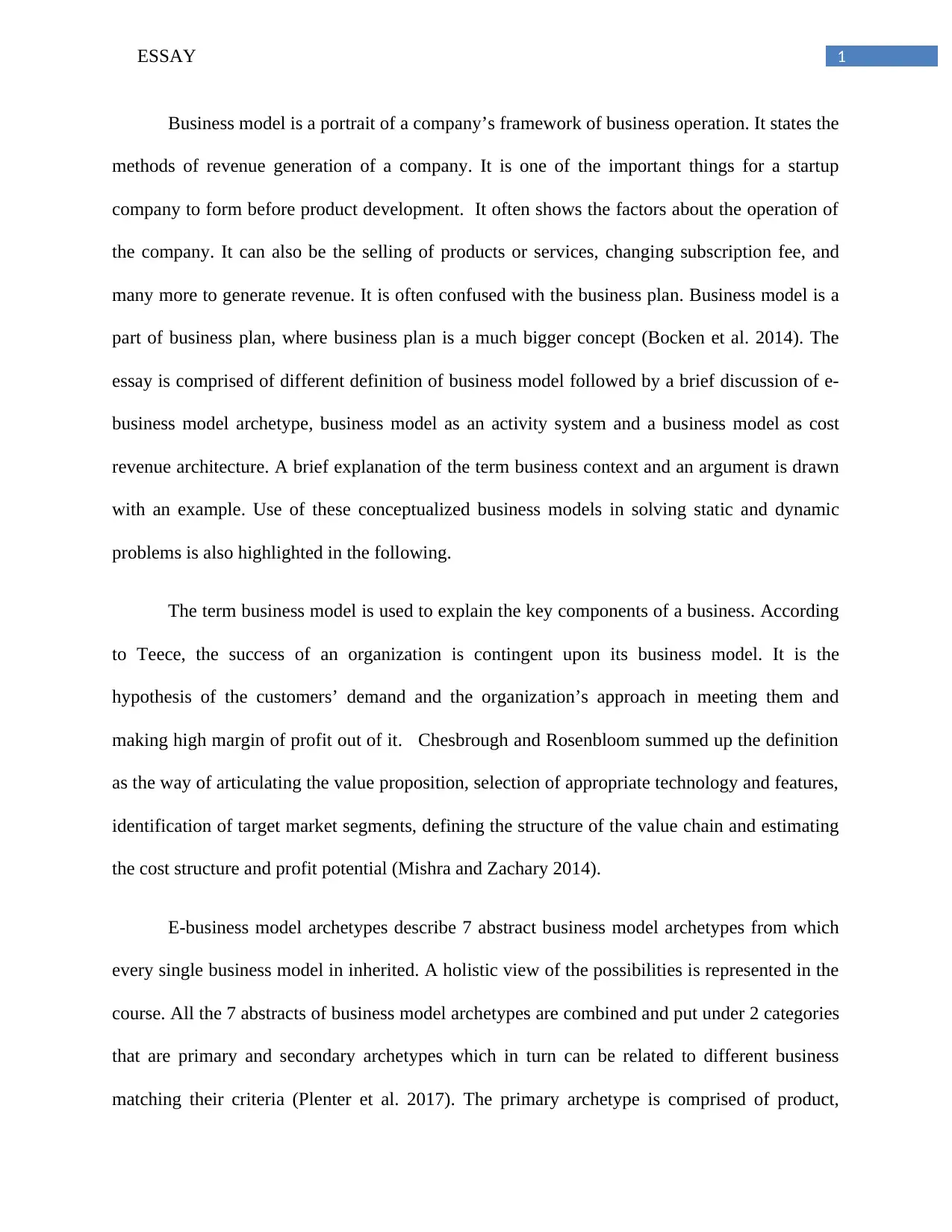
1ESSAY
Business model is a portrait of a company’s framework of business operation. It states the
methods of revenue generation of a company. It is one of the important things for a startup
company to form before product development. It often shows the factors about the operation of
the company. It can also be the selling of products or services, changing subscription fee, and
many more to generate revenue. It is often confused with the business plan. Business model is a
part of business plan, where business plan is a much bigger concept (Bocken et al. 2014). The
essay is comprised of different definition of business model followed by a brief discussion of e-
business model archetype, business model as an activity system and a business model as cost
revenue architecture. A brief explanation of the term business context and an argument is drawn
with an example. Use of these conceptualized business models in solving static and dynamic
problems is also highlighted in the following.
The term business model is used to explain the key components of a business. According
to Teece, the success of an organization is contingent upon its business model. It is the
hypothesis of the customers’ demand and the organization’s approach in meeting them and
making high margin of profit out of it. Chesbrough and Rosenbloom summed up the definition
as the way of articulating the value proposition, selection of appropriate technology and features,
identification of target market segments, defining the structure of the value chain and estimating
the cost structure and profit potential (Mishra and Zachary 2014).
E-business model archetypes describe 7 abstract business model archetypes from which
every single business model in inherited. A holistic view of the possibilities is represented in the
course. All the 7 abstracts of business model archetypes are combined and put under 2 categories
that are primary and secondary archetypes which in turn can be related to different business
matching their criteria (Plenter et al. 2017). The primary archetype is comprised of product,
Business model is a portrait of a company’s framework of business operation. It states the
methods of revenue generation of a company. It is one of the important things for a startup
company to form before product development. It often shows the factors about the operation of
the company. It can also be the selling of products or services, changing subscription fee, and
many more to generate revenue. It is often confused with the business plan. Business model is a
part of business plan, where business plan is a much bigger concept (Bocken et al. 2014). The
essay is comprised of different definition of business model followed by a brief discussion of e-
business model archetype, business model as an activity system and a business model as cost
revenue architecture. A brief explanation of the term business context and an argument is drawn
with an example. Use of these conceptualized business models in solving static and dynamic
problems is also highlighted in the following.
The term business model is used to explain the key components of a business. According
to Teece, the success of an organization is contingent upon its business model. It is the
hypothesis of the customers’ demand and the organization’s approach in meeting them and
making high margin of profit out of it. Chesbrough and Rosenbloom summed up the definition
as the way of articulating the value proposition, selection of appropriate technology and features,
identification of target market segments, defining the structure of the value chain and estimating
the cost structure and profit potential (Mishra and Zachary 2014).
E-business model archetypes describe 7 abstract business model archetypes from which
every single business model in inherited. A holistic view of the possibilities is represented in the
course. All the 7 abstracts of business model archetypes are combined and put under 2 categories
that are primary and secondary archetypes which in turn can be related to different business
matching their criteria (Plenter et al. 2017). The primary archetype is comprised of product,
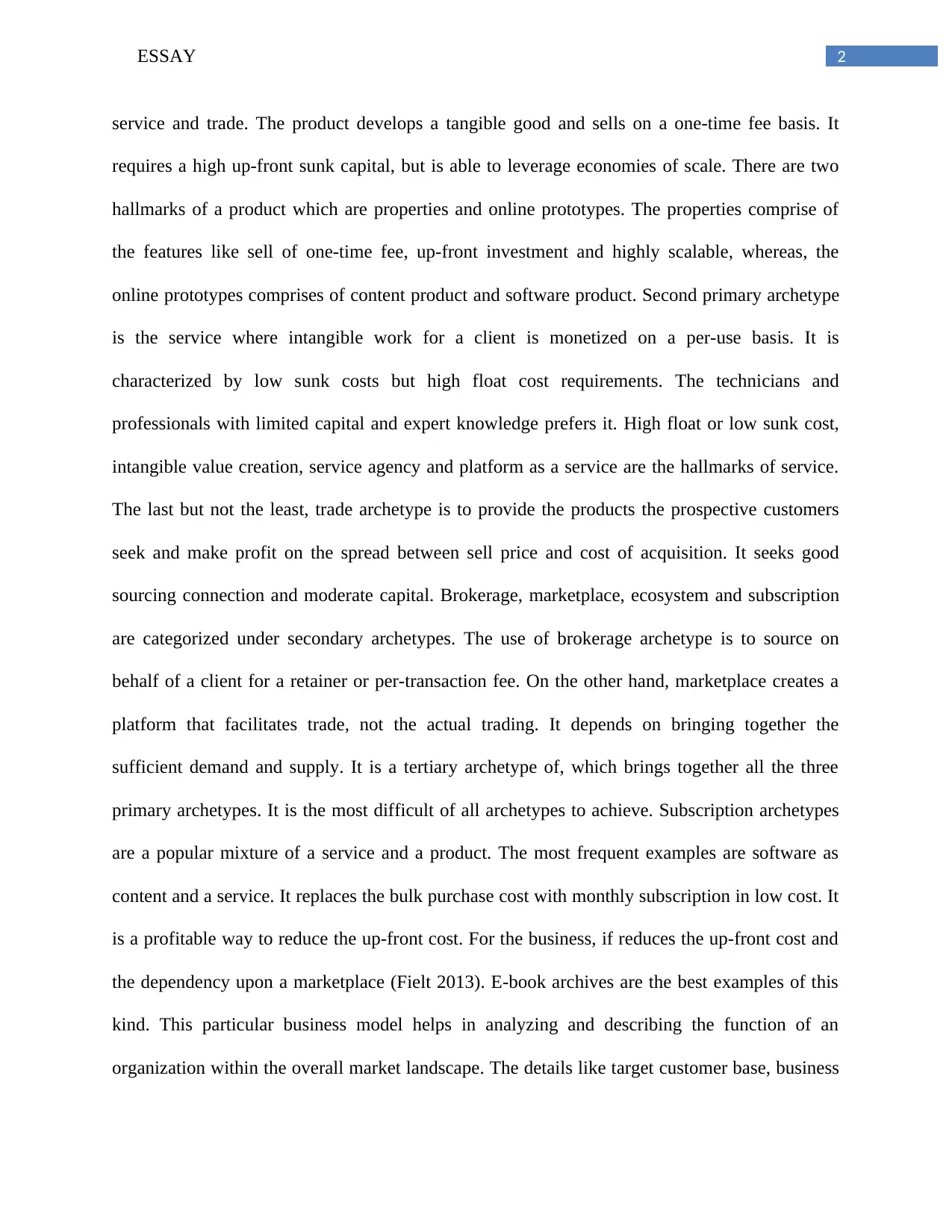
2ESSAY
service and trade. The product develops a tangible good and sells on a one-time fee basis. It
requires a high up-front sunk capital, but is able to leverage economies of scale. There are two
hallmarks of a product which are properties and online prototypes. The properties comprise of
the features like sell of one-time fee, up-front investment and highly scalable, whereas, the
online prototypes comprises of content product and software product. Second primary archetype
is the service where intangible work for a client is monetized on a per-use basis. It is
characterized by low sunk costs but high float cost requirements. The technicians and
professionals with limited capital and expert knowledge prefers it. High float or low sunk cost,
intangible value creation, service agency and platform as a service are the hallmarks of service.
The last but not the least, trade archetype is to provide the products the prospective customers
seek and make profit on the spread between sell price and cost of acquisition. It seeks good
sourcing connection and moderate capital. Brokerage, marketplace, ecosystem and subscription
are categorized under secondary archetypes. The use of brokerage archetype is to source on
behalf of a client for a retainer or per-transaction fee. On the other hand, marketplace creates a
platform that facilitates trade, not the actual trading. It depends on bringing together the
sufficient demand and supply. It is a tertiary archetype of, which brings together all the three
primary archetypes. It is the most difficult of all archetypes to achieve. Subscription archetypes
are a popular mixture of a service and a product. The most frequent examples are software as
content and a service. It replaces the bulk purchase cost with monthly subscription in low cost. It
is a profitable way to reduce the up-front cost. For the business, if reduces the up-front cost and
the dependency upon a marketplace (Fielt 2013). E-book archives are the best examples of this
kind. This particular business model helps in analyzing and describing the function of an
organization within the overall market landscape. The details like target customer base, business
service and trade. The product develops a tangible good and sells on a one-time fee basis. It
requires a high up-front sunk capital, but is able to leverage economies of scale. There are two
hallmarks of a product which are properties and online prototypes. The properties comprise of
the features like sell of one-time fee, up-front investment and highly scalable, whereas, the
online prototypes comprises of content product and software product. Second primary archetype
is the service where intangible work for a client is monetized on a per-use basis. It is
characterized by low sunk costs but high float cost requirements. The technicians and
professionals with limited capital and expert knowledge prefers it. High float or low sunk cost,
intangible value creation, service agency and platform as a service are the hallmarks of service.
The last but not the least, trade archetype is to provide the products the prospective customers
seek and make profit on the spread between sell price and cost of acquisition. It seeks good
sourcing connection and moderate capital. Brokerage, marketplace, ecosystem and subscription
are categorized under secondary archetypes. The use of brokerage archetype is to source on
behalf of a client for a retainer or per-transaction fee. On the other hand, marketplace creates a
platform that facilitates trade, not the actual trading. It depends on bringing together the
sufficient demand and supply. It is a tertiary archetype of, which brings together all the three
primary archetypes. It is the most difficult of all archetypes to achieve. Subscription archetypes
are a popular mixture of a service and a product. The most frequent examples are software as
content and a service. It replaces the bulk purchase cost with monthly subscription in low cost. It
is a profitable way to reduce the up-front cost. For the business, if reduces the up-front cost and
the dependency upon a marketplace (Fielt 2013). E-book archives are the best examples of this
kind. This particular business model helps in analyzing and describing the function of an
organization within the overall market landscape. The details like target customer base, business
⊘ This is a preview!⊘
Do you want full access?
Subscribe today to unlock all pages.

Trusted by 1+ million students worldwide
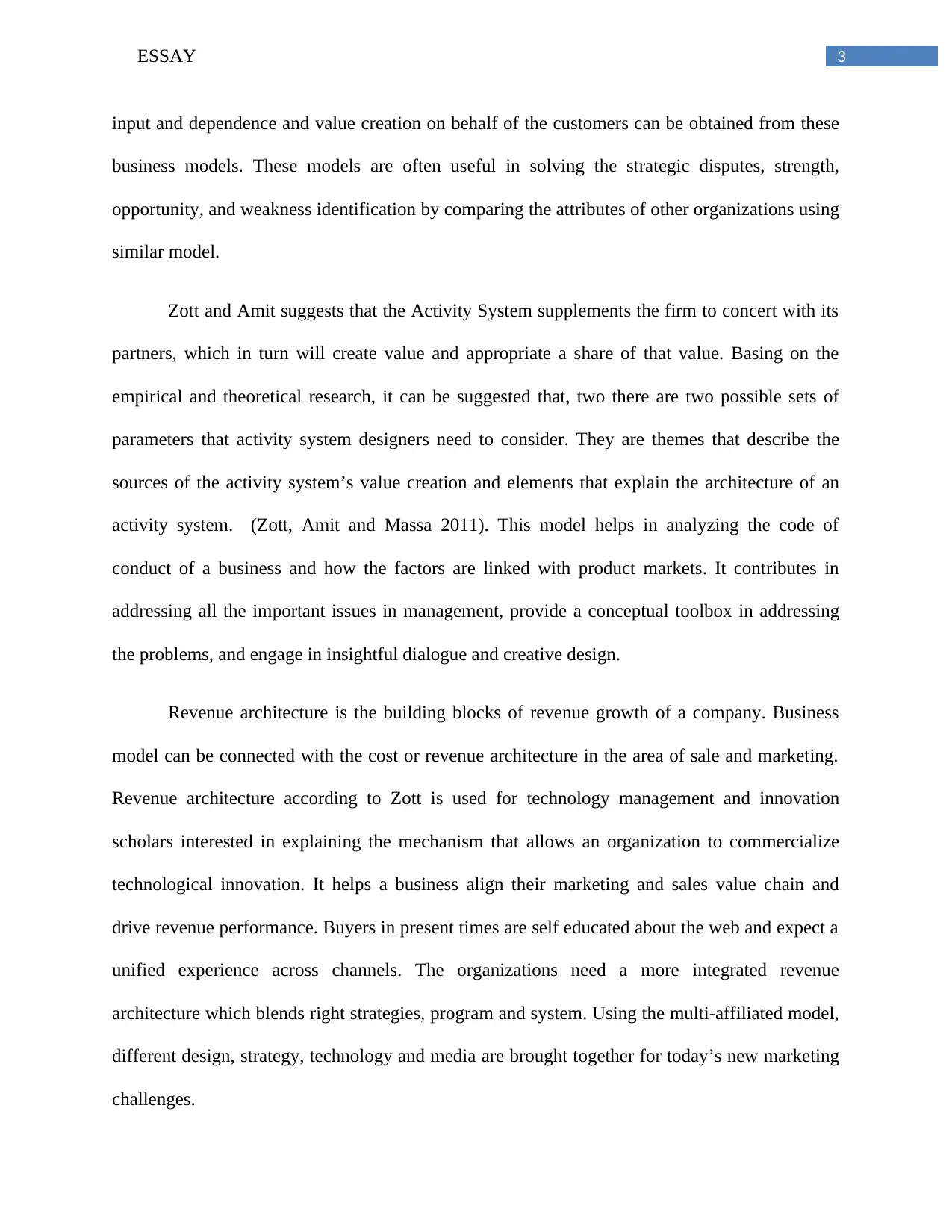
3ESSAY
input and dependence and value creation on behalf of the customers can be obtained from these
business models. These models are often useful in solving the strategic disputes, strength,
opportunity, and weakness identification by comparing the attributes of other organizations using
similar model.
Zott and Amit suggests that the Activity System supplements the firm to concert with its
partners, which in turn will create value and appropriate a share of that value. Basing on the
empirical and theoretical research, it can be suggested that, two there are two possible sets of
parameters that activity system designers need to consider. They are themes that describe the
sources of the activity system’s value creation and elements that explain the architecture of an
activity system. (Zott, Amit and Massa 2011). This model helps in analyzing the code of
conduct of a business and how the factors are linked with product markets. It contributes in
addressing all the important issues in management, provide a conceptual toolbox in addressing
the problems, and engage in insightful dialogue and creative design.
Revenue architecture is the building blocks of revenue growth of a company. Business
model can be connected with the cost or revenue architecture in the area of sale and marketing.
Revenue architecture according to Zott is used for technology management and innovation
scholars interested in explaining the mechanism that allows an organization to commercialize
technological innovation. It helps a business align their marketing and sales value chain and
drive revenue performance. Buyers in present times are self educated about the web and expect a
unified experience across channels. The organizations need a more integrated revenue
architecture which blends right strategies, program and system. Using the multi-affiliated model,
different design, strategy, technology and media are brought together for today’s new marketing
challenges.
input and dependence and value creation on behalf of the customers can be obtained from these
business models. These models are often useful in solving the strategic disputes, strength,
opportunity, and weakness identification by comparing the attributes of other organizations using
similar model.
Zott and Amit suggests that the Activity System supplements the firm to concert with its
partners, which in turn will create value and appropriate a share of that value. Basing on the
empirical and theoretical research, it can be suggested that, two there are two possible sets of
parameters that activity system designers need to consider. They are themes that describe the
sources of the activity system’s value creation and elements that explain the architecture of an
activity system. (Zott, Amit and Massa 2011). This model helps in analyzing the code of
conduct of a business and how the factors are linked with product markets. It contributes in
addressing all the important issues in management, provide a conceptual toolbox in addressing
the problems, and engage in insightful dialogue and creative design.
Revenue architecture is the building blocks of revenue growth of a company. Business
model can be connected with the cost or revenue architecture in the area of sale and marketing.
Revenue architecture according to Zott is used for technology management and innovation
scholars interested in explaining the mechanism that allows an organization to commercialize
technological innovation. It helps a business align their marketing and sales value chain and
drive revenue performance. Buyers in present times are self educated about the web and expect a
unified experience across channels. The organizations need a more integrated revenue
architecture which blends right strategies, program and system. Using the multi-affiliated model,
different design, strategy, technology and media are brought together for today’s new marketing
challenges.
Paraphrase This Document
Need a fresh take? Get an instant paraphrase of this document with our AI Paraphraser
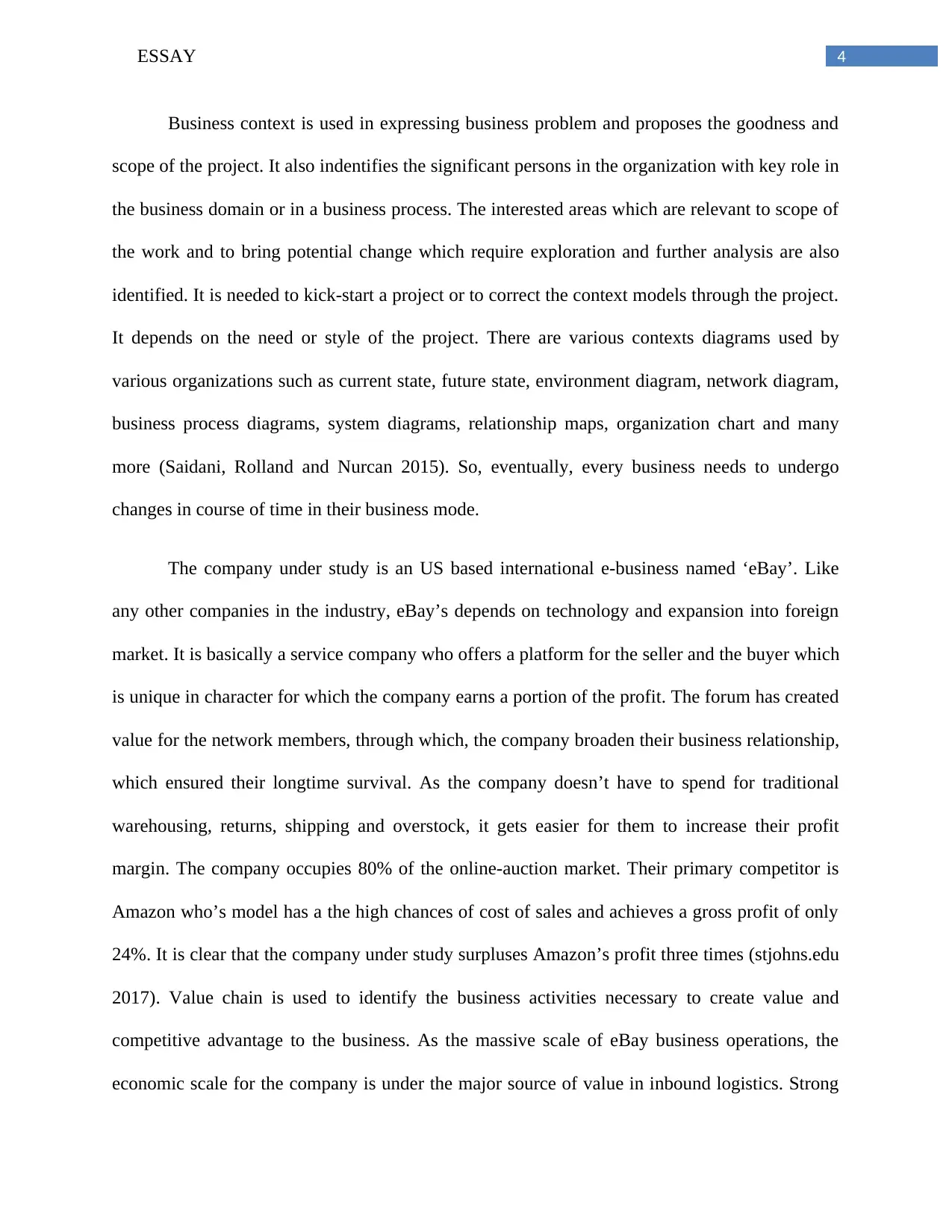
4ESSAY
Business context is used in expressing business problem and proposes the goodness and
scope of the project. It also indentifies the significant persons in the organization with key role in
the business domain or in a business process. The interested areas which are relevant to scope of
the work and to bring potential change which require exploration and further analysis are also
identified. It is needed to kick-start a project or to correct the context models through the project.
It depends on the need or style of the project. There are various contexts diagrams used by
various organizations such as current state, future state, environment diagram, network diagram,
business process diagrams, system diagrams, relationship maps, organization chart and many
more (Saidani, Rolland and Nurcan 2015). So, eventually, every business needs to undergo
changes in course of time in their business mode.
The company under study is an US based international e-business named ‘eBay’. Like
any other companies in the industry, eBay’s depends on technology and expansion into foreign
market. It is basically a service company who offers a platform for the seller and the buyer which
is unique in character for which the company earns a portion of the profit. The forum has created
value for the network members, through which, the company broaden their business relationship,
which ensured their longtime survival. As the company doesn’t have to spend for traditional
warehousing, returns, shipping and overstock, it gets easier for them to increase their profit
margin. The company occupies 80% of the online-auction market. Their primary competitor is
Amazon who’s model has a the high chances of cost of sales and achieves a gross profit of only
24%. It is clear that the company under study surpluses Amazon’s profit three times (stjohns.edu
2017). Value chain is used to identify the business activities necessary to create value and
competitive advantage to the business. As the massive scale of eBay business operations, the
economic scale for the company is under the major source of value in inbound logistics. Strong
Business context is used in expressing business problem and proposes the goodness and
scope of the project. It also indentifies the significant persons in the organization with key role in
the business domain or in a business process. The interested areas which are relevant to scope of
the work and to bring potential change which require exploration and further analysis are also
identified. It is needed to kick-start a project or to correct the context models through the project.
It depends on the need or style of the project. There are various contexts diagrams used by
various organizations such as current state, future state, environment diagram, network diagram,
business process diagrams, system diagrams, relationship maps, organization chart and many
more (Saidani, Rolland and Nurcan 2015). So, eventually, every business needs to undergo
changes in course of time in their business mode.
The company under study is an US based international e-business named ‘eBay’. Like
any other companies in the industry, eBay’s depends on technology and expansion into foreign
market. It is basically a service company who offers a platform for the seller and the buyer which
is unique in character for which the company earns a portion of the profit. The forum has created
value for the network members, through which, the company broaden their business relationship,
which ensured their longtime survival. As the company doesn’t have to spend for traditional
warehousing, returns, shipping and overstock, it gets easier for them to increase their profit
margin. The company occupies 80% of the online-auction market. Their primary competitor is
Amazon who’s model has a the high chances of cost of sales and achieves a gross profit of only
24%. It is clear that the company under study surpluses Amazon’s profit three times (stjohns.edu
2017). Value chain is used to identify the business activities necessary to create value and
competitive advantage to the business. As the massive scale of eBay business operations, the
economic scale for the company is under the major source of value in inbound logistics. Strong
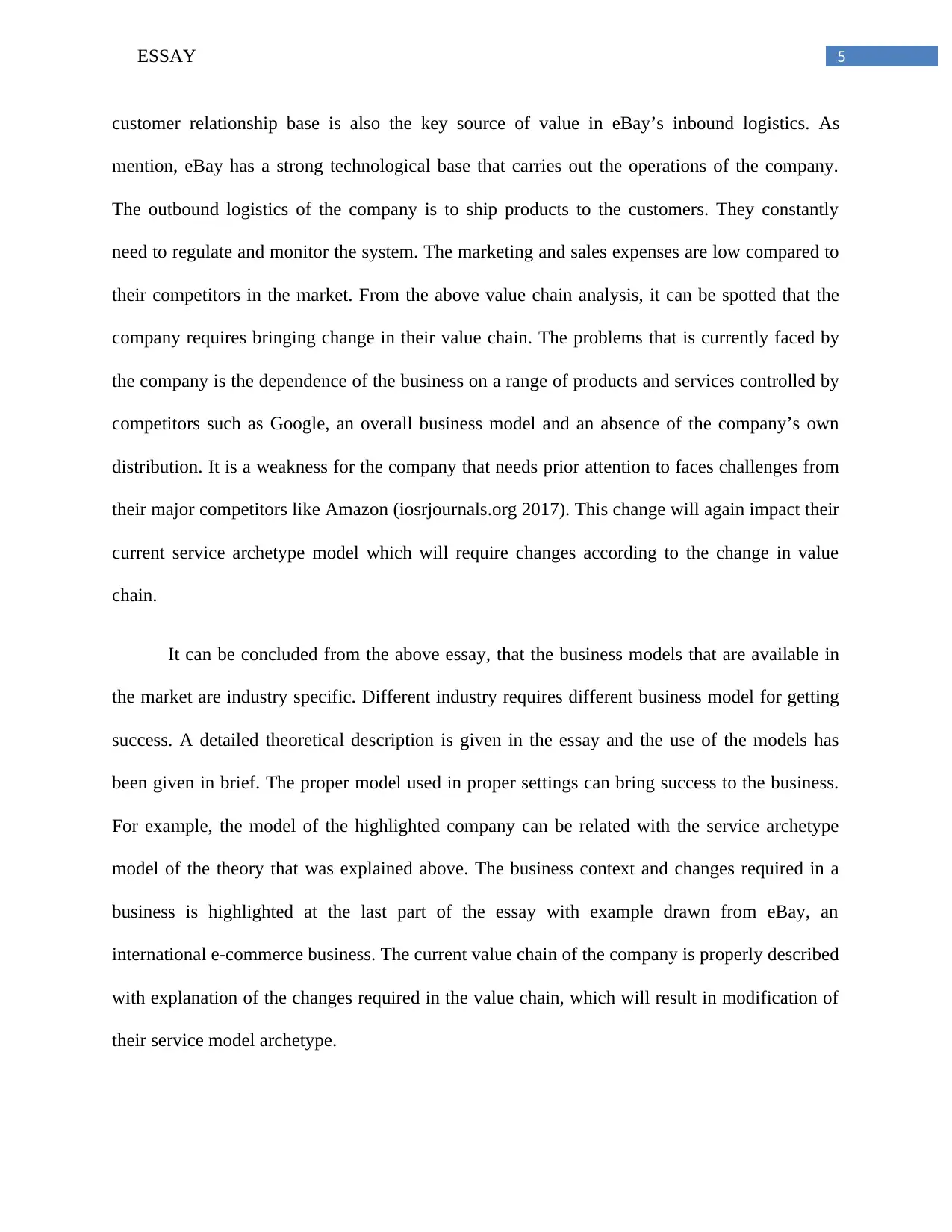
5ESSAY
customer relationship base is also the key source of value in eBay’s inbound logistics. As
mention, eBay has a strong technological base that carries out the operations of the company.
The outbound logistics of the company is to ship products to the customers. They constantly
need to regulate and monitor the system. The marketing and sales expenses are low compared to
their competitors in the market. From the above value chain analysis, it can be spotted that the
company requires bringing change in their value chain. The problems that is currently faced by
the company is the dependence of the business on a range of products and services controlled by
competitors such as Google, an overall business model and an absence of the company’s own
distribution. It is a weakness for the company that needs prior attention to faces challenges from
their major competitors like Amazon (iosrjournals.org 2017). This change will again impact their
current service archetype model which will require changes according to the change in value
chain.
It can be concluded from the above essay, that the business models that are available in
the market are industry specific. Different industry requires different business model for getting
success. A detailed theoretical description is given in the essay and the use of the models has
been given in brief. The proper model used in proper settings can bring success to the business.
For example, the model of the highlighted company can be related with the service archetype
model of the theory that was explained above. The business context and changes required in a
business is highlighted at the last part of the essay with example drawn from eBay, an
international e-commerce business. The current value chain of the company is properly described
with explanation of the changes required in the value chain, which will result in modification of
their service model archetype.
customer relationship base is also the key source of value in eBay’s inbound logistics. As
mention, eBay has a strong technological base that carries out the operations of the company.
The outbound logistics of the company is to ship products to the customers. They constantly
need to regulate and monitor the system. The marketing and sales expenses are low compared to
their competitors in the market. From the above value chain analysis, it can be spotted that the
company requires bringing change in their value chain. The problems that is currently faced by
the company is the dependence of the business on a range of products and services controlled by
competitors such as Google, an overall business model and an absence of the company’s own
distribution. It is a weakness for the company that needs prior attention to faces challenges from
their major competitors like Amazon (iosrjournals.org 2017). This change will again impact their
current service archetype model which will require changes according to the change in value
chain.
It can be concluded from the above essay, that the business models that are available in
the market are industry specific. Different industry requires different business model for getting
success. A detailed theoretical description is given in the essay and the use of the models has
been given in brief. The proper model used in proper settings can bring success to the business.
For example, the model of the highlighted company can be related with the service archetype
model of the theory that was explained above. The business context and changes required in a
business is highlighted at the last part of the essay with example drawn from eBay, an
international e-commerce business. The current value chain of the company is properly described
with explanation of the changes required in the value chain, which will result in modification of
their service model archetype.
⊘ This is a preview!⊘
Do you want full access?
Subscribe today to unlock all pages.

Trusted by 1+ million students worldwide
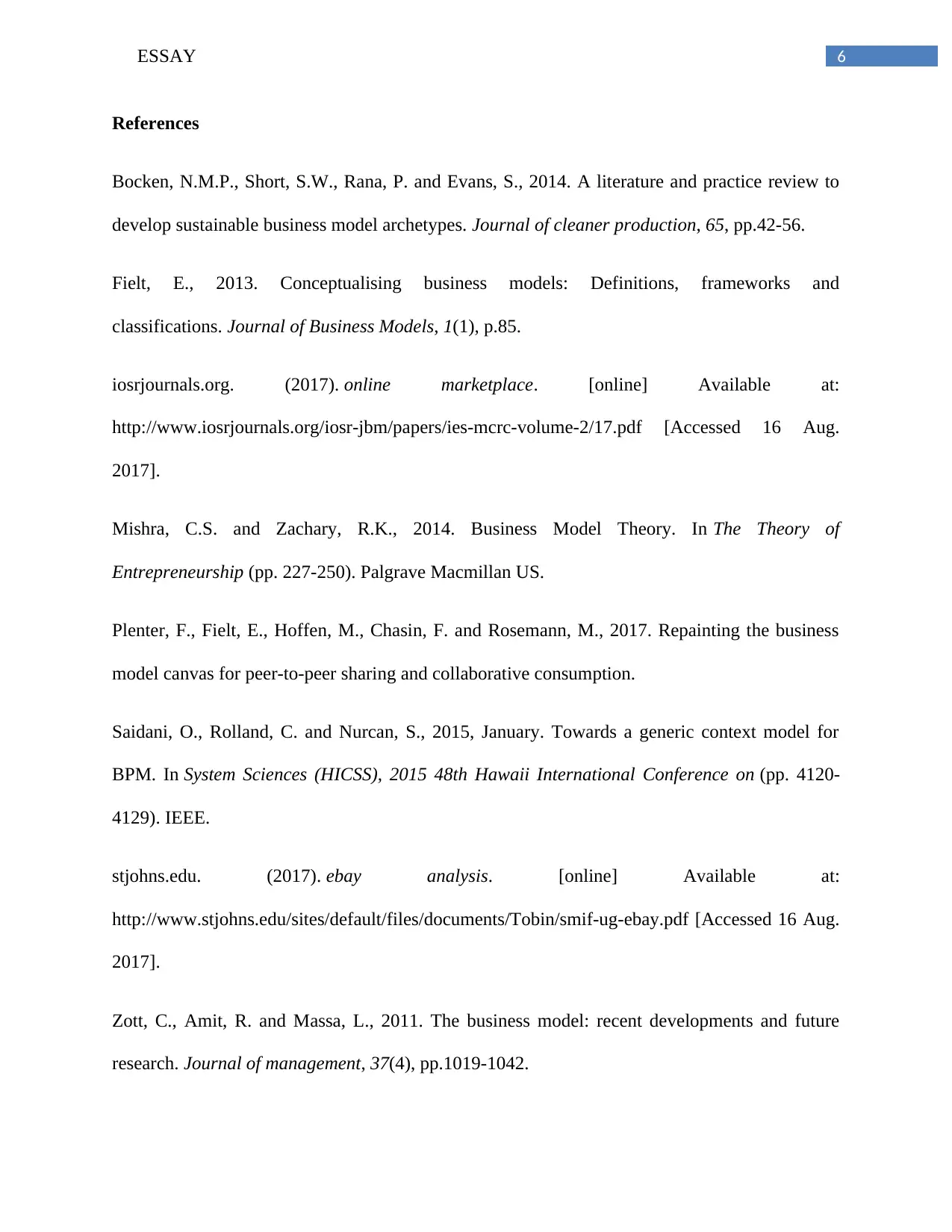
6ESSAY
References
Bocken, N.M.P., Short, S.W., Rana, P. and Evans, S., 2014. A literature and practice review to
develop sustainable business model archetypes. Journal of cleaner production, 65, pp.42-56.
Fielt, E., 2013. Conceptualising business models: Definitions, frameworks and
classifications. Journal of Business Models, 1(1), p.85.
iosrjournals.org. (2017). online marketplace. [online] Available at:
http://www.iosrjournals.org/iosr-jbm/papers/ies-mcrc-volume-2/17.pdf [Accessed 16 Aug.
2017].
Mishra, C.S. and Zachary, R.K., 2014. Business Model Theory. In The Theory of
Entrepreneurship (pp. 227-250). Palgrave Macmillan US.
Plenter, F., Fielt, E., Hoffen, M., Chasin, F. and Rosemann, M., 2017. Repainting the business
model canvas for peer-to-peer sharing and collaborative consumption.
Saidani, O., Rolland, C. and Nurcan, S., 2015, January. Towards a generic context model for
BPM. In System Sciences (HICSS), 2015 48th Hawaii International Conference on (pp. 4120-
4129). IEEE.
stjohns.edu. (2017). ebay analysis. [online] Available at:
http://www.stjohns.edu/sites/default/files/documents/Tobin/smif-ug-ebay.pdf [Accessed 16 Aug.
2017].
Zott, C., Amit, R. and Massa, L., 2011. The business model: recent developments and future
research. Journal of management, 37(4), pp.1019-1042.
References
Bocken, N.M.P., Short, S.W., Rana, P. and Evans, S., 2014. A literature and practice review to
develop sustainable business model archetypes. Journal of cleaner production, 65, pp.42-56.
Fielt, E., 2013. Conceptualising business models: Definitions, frameworks and
classifications. Journal of Business Models, 1(1), p.85.
iosrjournals.org. (2017). online marketplace. [online] Available at:
http://www.iosrjournals.org/iosr-jbm/papers/ies-mcrc-volume-2/17.pdf [Accessed 16 Aug.
2017].
Mishra, C.S. and Zachary, R.K., 2014. Business Model Theory. In The Theory of
Entrepreneurship (pp. 227-250). Palgrave Macmillan US.
Plenter, F., Fielt, E., Hoffen, M., Chasin, F. and Rosemann, M., 2017. Repainting the business
model canvas for peer-to-peer sharing and collaborative consumption.
Saidani, O., Rolland, C. and Nurcan, S., 2015, January. Towards a generic context model for
BPM. In System Sciences (HICSS), 2015 48th Hawaii International Conference on (pp. 4120-
4129). IEEE.
stjohns.edu. (2017). ebay analysis. [online] Available at:
http://www.stjohns.edu/sites/default/files/documents/Tobin/smif-ug-ebay.pdf [Accessed 16 Aug.
2017].
Zott, C., Amit, R. and Massa, L., 2011. The business model: recent developments and future
research. Journal of management, 37(4), pp.1019-1042.
1 out of 7
Your All-in-One AI-Powered Toolkit for Academic Success.
+13062052269
info@desklib.com
Available 24*7 on WhatsApp / Email
![[object Object]](/_next/static/media/star-bottom.7253800d.svg)
Unlock your academic potential
Copyright © 2020–2025 A2Z Services. All Rights Reserved. Developed and managed by ZUCOL.


